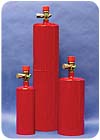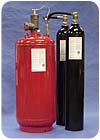
What happens when a fire breaks out in a manufacturing facility? If the facility is code compliant, it is equipped with an integrated fire detection, alarm and sprinkler system. The detectors sense the presence of smoke, alarms sound and the fire department is summoned. In the meantime, building occupants are given instructions, and the sprinklers activate in the area where the fire is located. The water contains the fire and provides protection for the occupants until the fire department arrives and extinguishes the fire.
The emergency event just described can last anywhere from 30 minutes to several hours. If the fire sprinklers are activated, there will most certainly be clean-up operations, requiring days and possibly weeks to complete. While this approach to fire safety affords excellent protection for the structure of the building, as well as its occupants, it is unacceptable for safeguarding critical hazard areas within the facility, such as a control room.
The primary problem associated with sprinkler-based protection is one of time. Since the typical fire sprinkler system doesn't operate until the air temperature reaches 500°F-1,000°F, sensitive electronic equipment and critical data have already been destroyed by the time the water is discharged. However, this may be the least of the facility manager's concerns, since the water itself-often contaminated-can do more damage than the fire.
The second drawback is the length of business interruption caused by a water-suppressed fire. Not only is the damage more extensive, thus requiring time-consuming replacement of hardware, but drying out the control room can be a massive effort. Depending upon the size and importance of the control room to its owners and users, each hour of downtime can represent thousands of dollars in lost revenue.
The Anatomy of a Control Room Fire
Fires in control rooms typically start small, perhaps caused by a short circuit in a piece of electronic hardware or overheated wiring. Unfortunately, the incipient fire is often located in an underfloor area or inside a cabinet where it has the opportunity to grow in size and intensity without being noticed. Once there are actual flames and smoke, the devastation has already begun in earnest. The control room's personnel are put in peril, equipment is damaged and processes are shut down or severely interrupted.
According to a recent survey of CFOs, treasurers and risk managers conducted by FM Global, The National Association of Corporate Treasurers (NACT), and Sherbrooke Partners, the IT/telecommunications function in a corporation is rated one of the "Top 3 Earnings Drivers."
Step 1: Rapidly Detect the Fire
There are two proven methods for detecting a fire in a control room.The first is by means of a high-sensitivity smoke detector. These detectors employ sophisticated air-sampling techniques to identify potential fire situations before there is visible smoke or open flame. Air from the protected area-including the room and its subfloor area-is drawn continuously through a piping network into the detector where particles of combustion are measured at levels of obscuration as low as 0.0075% per foot. This is approximately 1,000 times more sensitive than a conventional smoke detector.
At this stage of a fire, only invisible products of combustion-such as the outgassing of electrical components-are present. This incipient stage is followed by visible smoke, flame, and finally, intense heat. By continuously sampling the air in a data center, a high-sensitivity system can detect airborne particles of combustion and provide the earliest warning possible, yet it is still immune to false alarms from dust or other containments.
The high-sensitivity type of detection often buys the facilities manager 30 minutes or more of advance warning in the event of a fire emergency. This time can be used to locate the source of the situation and take correction actions to prevent the fire from escalating and minimize the damage done to the data center and its vital contents.
The second method of fire detection is through the use of smoke detectors that feature a fully analog, microprocessor-based "brain."

Step 2: Control the Emergency Response
The hub of the fire protection system is the central control unit. Typically mounted right outside the control room, the control unit is also microprocessor based and acts as the focal point of the distributed intelligence system. It is responsible for monitoring inputs from the detectors and other devices, as well as maintaining the communications network necessary to report continuously on the status of the fire protection system.
In the event of a fire, the central control unit receives an alarm signal from one or more of the detectors in the protected area. It then initiates a series of "outputs,"
Step 3: Suppress the Fire
There are two main considerations when addressing clean agent fire suppression in a control room: the configuration of the system and the fire suppression agent of choice.
Clean agent fire suppression systems are custom engineered to fit each control room application. There are, however, three basic elements that are common to each type of system: the container(s) to store the fire suppression agent; a network of piping to deliver the agent to the hazard area; and strategically positioned nozzles to distribute the agent to all parts of the protected enclosure.


Similar to Halon 1301, this new generation of gaseous agents are extremely effective on Class A, B and C fires. And, like Halon 1301, they are electrically non-conductive, safe for people and require no after-fire cleanup.
Newer clean agents also have zero Ozone Depletion Potential (ODP) and are listed on the U.S. Environmental Protection Agency's SNAP List as an acceptable alternative to Halon 1301 for use in occupied and unoccupied areas with no restriction. For this reason, this type of clean agent is the choice of many fire protection engineers around the world.
Inerting agents, such as Argonite, provide an additional type of clean agent fire suppression. Argonite is a blend of natural gases that works on a fire by depriving it of the oxygen it needs. Inerting agents such as Argonite have zero Ozone Depletion Potential and no atmospheric lifetime. Argonite is ideally suited for areas that are subject to leakage and that cannot be adequately sealed.
Beyond Hardware and Agent
Whether you're retrofitting a Halon system in an existing control room, expanding your current facility or constructing a new control room, there is more to protecting your assets and business continuity than choosing fire protection hardware and agent.A good first step is to consult a company that specializes in special hazards fire protection. Make sure the fire protection design engineers in the company have been trained by the manufacturer to design, install and service clean agent fire protection systems for special applications like yours. These professionals will then be qualified to assess your fire protection requirements, review applicable local and national fire codes, and recommend a solution that is both effective and affordable.
Furthermore, a qualified fire protection company will be able to custom design your system, perform the necessary piping/hydraulic calculations and provide a smooth installation that minimizes any interruption to your facility's operations. Finally, they will train your control room staff on the basic operation and care of the fire protection system, as well as provide 24/7 service.
When it comes to protecting your control room against fire, don't be satisfied with a water-based sprinkler system designed to safeguard a structure. Calculate what an interruption in the operation of the control room would cost your company and then demand a fire protection system that is designed to detect a fire faster, control the emergency situation seamlessly and suppress the fire without the use of water.